Expert Tips on Tree Trimming and Knowing When to Opt for Total Tree Removal
Trees are an essential part of our environment, providing shade, beauty, and a habitat for wildlife. Proper maintenance, including tree trimming and sometimes total tree removal, is crucial for the health of your trees and the safety of your property. In this article, we will explore expert tips on tree trimming and guide you on when to consider total tree removal.
Understanding Tree Trimming
Benefits of Tree Trimming
Tree trimming is a vital aspect of tree care. Regular trimming ensures the health and aesthetic appeal of your trees. Here are some benefits of tree trimming:
- Promotes Health: Removing dead or diseased branches prevents decay and improves the overall health of the tree.
- Enhances Appearance: Well-trimmed trees look attractive and can enhance the curb appeal of your property.
- Increases Sunlight and Airflow: Trimming allows more sunlight and air to reach the tree and the plants beneath it, promoting better growth.
- Prevents Hazards: Regular trimming removes weak or overhanging branches that could pose a risk to people and property during storms.
When to Trim Your Trees
Tree trimming should be done at the right time to maximize its benefits. Here are some tips:
- Seasonal Trimming: The best time to trim most trees is during their dormant season, usually in late winter or early spring.
- Immediate Needs: Trim any dead, damaged, or diseased branches as soon as they are noticed.
- Safety Concerns: If branches are interfering with power lines, buildings, or are a hazard, trim them immediately.
Knowing When to Opt for Total Tree Removal
While tree trimming can often solve many issues, there are times when total tree removal is the best option. Here are some scenarios where tree removal might be necessary:
Diseased or Dying Trees
A tree that is severely diseased or dying poses a significant risk. If the tree is beyond saving, removing it is the safest option. Signs of a dying tree include:
- Mushroom Growth: Fungi growing at the base of the tree can indicate internal rot.
- Cracks or Splits: Large cracks or splits in the trunk or branches can compromise the tree’s structural integrity.
- Leaf Loss: Extensive leaf loss, especially during the growing season, is a sign of poor health.
Structural Damage
Trees that have suffered significant structural damage from storms, lightning, or other causes may not be stable. In such cases, total tree removal is often necessary to prevent accidents.
Interference with Infrastructure
Trees growing too close to buildings, power lines, or underground utilities can cause substantial damage. If trimming is not sufficient to mitigate the risk, tree removal may be required.
Landscape Renovation
In some cases, tree removal is part of a broader landscape renovation plan. Removing a tree might be necessary to make space for new construction, landscaping features, or to improve the overall aesthetics of your property.
The Process of Tree Trimming and Removal
Hiring a Professional
Tree trimming and removal are tasks best left to professionals. Arborists have the expertise and equipment to handle these jobs safely and efficiently. When hiring a professional, consider the following:
- Certification: Ensure the arborist is certified and has the necessary credentials.
- Insurance: Verify that the company is insured to cover any potential damage or injuries.
- Reputation: Look for reviews and testimonials to gauge the company’s reliability and quality of service.
The Tree Trimming Process
A professional tree trimming service typically involves:
- Inspection: The arborist inspects the tree to identify which branches need to be trimmed.
- Trimming: Using specialized tools, the arborist carefully removes the selected branches.
- Clean-Up: After trimming, the area is cleaned up, and the debris is disposed of properly.
The Tree Removal Process
Total Tree Removal is a more complex process and involves several steps:
- Assessment: The arborist assesses the tree and the surrounding area to plan the removal process.
- Cutting: The tree is cut down in sections, starting from the top and working downwards.
- Stump Removal: The remaining stump is either ground down or removed entirely, depending on your preference.
- Disposal: The tree and stump debris are removed from the site, leaving the area clean and safe.
Conclusion
Tree trimming and total tree removal are essential aspects of tree care that ensure the health of your trees and the safety of your property. Regular trimming promotes tree health and aesthetics, while total removal is sometimes necessary for safety or landscape design purposes. Always hire a professional arborist for these tasks to ensure they are done correctly and safely. By following these expert tips, you can maintain a beautiful and safe outdoor space.















